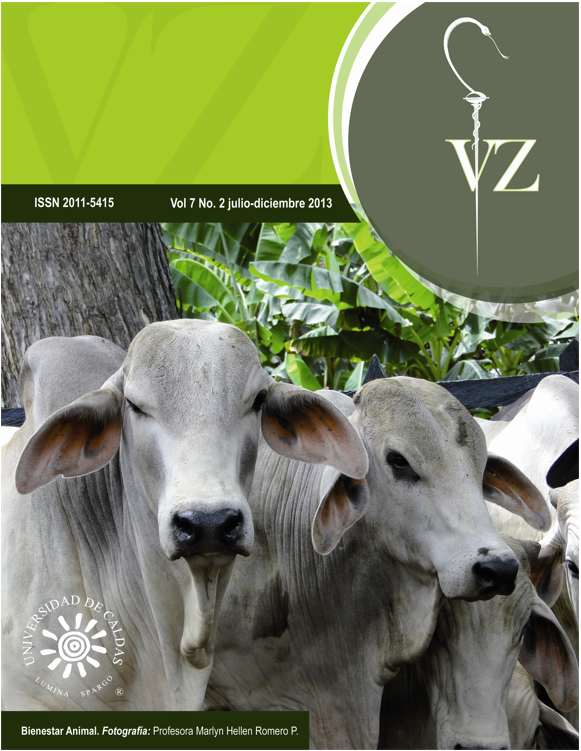Autores/as
Resumen
RESUMEN: Determinar los requerimientos nutricionales de Met+Cys para aves de postura semipesadas, estimados por medio de los modelos de regresión y el LRP (linear response plateau). 288 Aves de postura semipesadas distribuidas en seis tratamientos fueron alimentadas de la semana 22 a la semana 38 de edad, con una dieta básica que contenía 14,4% de proteína bruta a la cual se le adicionó seis niveles de DL-metionina (0,00; 0,05; 0,10; 0,15; 0,20 y 0,25%), para obtener tratamientos con 0,484; 0,534; 0,584; 0,634; 0,684 y 0,734% de Met+Cys. El nivel creciente de Met+Cys en la dieta, de 0,484 a 0,734% presentó un efecto cuadrático sobre la producción, peso de huevo, masa de huevo y conversión alimenticia. También se observó efecto lineal sobre el mejoramiento de la calidad interna del huevo al medir Unidades Haugh y el índice de albumen. Por medio del modelo LRP, los niveles mínimos de Met+Cys que maximizaron la producción, peso y masa de huevos y presentaron la mejor conversión alimenticia fueron los de 5,53, 5,85, 5,60 y 5,62 g de Met+Cys/kg de alimento, respectivamente. Ya a través del modelo cuadrático, los niveles de Met+Cys que maximizaron la producción, peso y masa de huevo y minimizaron la conversión alimenticia fueron 6,72, 6,68, 6,72 y 6,82 g/kg de alimento, respectivamente. En resumen, el incremento de Met+Cys utilizando DL-metionina mejoró significativamente el desempeño de las aves de postura. Por lo anterior, aves de postura semipesadas requieren 6.735 g de Met+Cys/kg de alimento o 775 mg de Met+Cys/ave/día de la semana 22 a la semana 38 de edad (con un consumo diario de 115 g/ave).
Palabras clave
Citas
Baker, D.H. Ideal amino acid patterns for broiler chicks. In: D’Mello, F.JP. (Ed). Amino Acids in Animal Nutrition. 2nd ed. Wallingford: CAB International, 2003. p.223-235.
Baker, D.H.; Batal, A.B.; Parr, T.M. et al. Ideal ratio (relative to lysine) of tryptophan, threonine, isoleucine and valine for chicks during the second and third week of life. Poultry Science, v.81, p.485-494, 2002.
Baker, D.H.; Fernandez, S.R.; Webel, D.M. et al. Sulfur amino acid requirements and cystine replacement value of broiler chicks during the period three to six weeks posthatching. Poultry Science, v.75, n.6, p.737-742, 1996.
Bertram, H.L.; Danner, K.J.; Jeroch, H. Effect of DLmethionine in a cereal-pea diet on the performance ob brown laying hens. Arch Geflügelk, v.59, 1995, p.103- 107.
Cao, Z.; Jevne, C.J.; Coon, C.N. The methionine requirement of laying hens as affected by dietary protein levels. Poultry Science, v.71, 1992 (suppl.39).
Emmert, J.L.; Barker, D.H. Use of the ideal protein concept for precision formulation of amino acid levels in broiler diets. Journal of Applied Poultry Research, v.6, p.462-470, 1997.
Harper, A.E. Amino acid imbalances, toxicities and antagonisms. Nutr Rev, v.14, n.8, p.225-227, 1956.
Harper, A.E.; Benevenga, N.J.; Wohlhueter, R.M. Effects of ingestion of disproportionate amounts of amino acids. Physiological Reviews, v.50, n.3, p.428- 558, 1970.
Liu, Z.; Wu, G.; Bryant, M.M. et al. Influence of added synthetic lysine in low-protein diets with the methionine plus cysteine to lysine ratio maintained at 0.75. Journal of Applied Poultry Research, v.14, n.1, p.174-182, 2005.
Lohmann Tierzucht GMBH. Lohmann Brown Management Guide. Germany: German Lohmann Tierzucht GmbH, 2005.
Morris, T.R. The interpretation of response data from animal feeding trial. In: Cole, DJA & Haresign, W. (Eds). Recent Developments in Poultry Nutrition 2. Boston: Butterworths, 1989. p.1-11.
Novak, C.; Yakout, H.; Scheideler, S. The combined effects of dietary lysine and total sulfur amino acid level on egg production parameters and egg components in Dekalb Delta laying hens. Poultry Science, v.83, n.6, p.977-984, 2004.
NRC, National Research Council. Nutrients Requirements of Poultry. Washington D.C.: National Academic Press, 1994.
Parr, T.M.; Kerr, B.J.; Baker, D.H. Isoleucine requirement of growing (25 to 45 kg) pigs. Journal of Animal Science, v.81, n.3, p.745-752, 2003.
Robbins, K.R.; Norton, H.W.; Barker, D.H. Estimation of nutrient requirements from growth data. The Journal of Nutrition, v.109, p.1710-1714, 1979.
SAS Institute Inc. SAS® user’s guide: Statistics, Version 5.0. Ed. Cary, NC, USA, SAS Institute Inc., 1996. 956p.
Schutte, J.B.; De Jong, J.; Bertram, H.L. Requirement of the laying hen for sulfur amino acids. Poultry Science, v.73, n.2, p.274-280, 1994.
Schutte, J.B.; Van Werdem, E.J. Requirement of the hen for sulphur containing amino acids. British Poultry Science, v.19, n.5, p.573-581, 1978.
Wu, G.; Bryant, M.M.; Roland, D.A.Sr. et al. Effect of synthetic lysine on performance of commercial Leghorns in Phase II and III (Second Cycle) while maintaining the
Methionine+Cysteine/Lysine ratio at 0.75. Poultry Science, v.84, p.2-22, 2005a (suppl.43).
Wu, G.; Bryant, M.M.; Voitle, R.A.; Roland, D.A.Sr. Effect of dietary energy on performance and egg composition in Bovans White and Dekalb White in Phase I. Poultry Science, v.84, n.10, p.1610-1615, 2005b.

 PDF
PDF
 FLIP
FLIP










